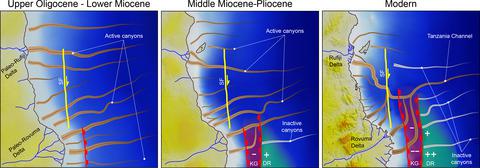当前位置:
X-MOL 学术
›
Basin Res.
›
论文详情
Our official English website, www.x-mol.net, welcomes your feedback! (Note: you will need to create a separate account there.)
Impact of the East African Rift System on the routing of the deep‐water drainage network offshore Tanzania, western Indian Ocean
Basin Research ( IF 3.2 ) Pub Date : 2019-08-25 , DOI: 10.1111/bre.12398 Vittorio Maselli 1, 2 , Dick Kroon 3 , David Iacopini 2 , Bridget S. Wade 4 , Paul N. Pearson 5 , Henk de Haas 6
Basin Research ( IF 3.2 ) Pub Date : 2019-08-25 , DOI: 10.1111/bre.12398 Vittorio Maselli 1, 2 , Dick Kroon 3 , David Iacopini 2 , Bridget S. Wade 4 , Paul N. Pearson 5 , Henk de Haas 6
Affiliation

|
[Abstract The East African Rift System (EARS) exerted a major influence on river drainage basins and regional climate of east Africa during the Cenozoic. Recent studies have highlighted an offshore branch of the EARS in the western Indian Ocean, where the Kerimbas Graben and the Davie Ridge represent its sea floor expression. To date, a clear picture of the impact and timing of this EARS offshore branch on the continental margin of the western Indian Ocean, and associated sediment dispersal pathways, is still missing. This study presents new evidence for four giant canyons along the northern portion of the Davie Ridge offshore Tanzania. Seismic and multibeam bathymetric data highlight that the southernmost three canyons are now inactive, supra‐elevated relative to the adjacent sea floor of the Kerimbas Graben and disconnected from the modern slope systems offshore the Rovuma and Rufiji River deltas. Regional correlation of dated seismic horizons, integrated with well data and sediment samples, proves that the tectonic activity driving the uplift of the Davie Ridge in this area has started during the middle‐upper Miocene and is still ongoing, as suggested by the presence of fault escarpments at the sea floor and by the location and magnitude of recent earthquakes. Our findings contribute to placing the Kerimbas Graben and the Davie Ridge offshore Tanzania in the regional geodynamic context of the western Indian Ocean and show how the tectonics of the offshore branch of the EARS modified the physiography of the margin, re‐routing the deep‐water drainage network since the middle Miocene. Future studies are needed to understand the influence of changing sea floor topography on the western Indian Ocean circulation and to evaluate the potential of the EARS offshore tectonics in generating tsunamigenic events., This study presents the discovery of four giant canyons along the northern portion of the Davie Ridge (western Indian Ocean). Three canyons are now inactive, supra‐elevated relative to the adjacent sea floor and disconnected from the modern slope systems offshore the Rovuma and Rufiji River deltas. The chronological constraints available suggest that the tectonic activity driving the uplift of the Davie Ridge in this area has started during the middle‐upper Miocene. Our findings contribute to placing the Kerimbas Graben and the Davie Ridge offshore Tanzania in the regional geodynamic context of the western Indian Ocean and show how the tectonics of the offshore branch of the EARS modified the physiography of the margin, re‐routing the deep‐water drainage network. ]
中文翻译:

东非裂谷系统对坦桑尼亚、西印度洋近海深水排水网络路线的影响
[摘要 东非裂谷系统(EARS)对新生代东非河流流域和区域气候产生了重大影响。最近的研究突出了 EARS 在西印度洋的一个离岸分支,其中 Kerimbas Graben 和 Davie Ridge 代表了它的海底表现。迄今为止,该 EARS 近海分支对西印度洋大陆边缘的影响和时间以及相关的沉积物扩散路径的清晰图像仍然缺失。这项研究为坦桑尼亚近海戴维岭北部的四个巨型峡谷提供了新的证据。地震和多波束测深数据突出显示,最南端的三个峡谷现在处于非活动状态,相对于邻近的 Kerimbas Graben 海床海拔更高,与鲁伍马河和鲁菲吉河三角洲近海的现代斜坡系统断开。年代地震层的区域对比,结合井数据和沉积物样品,证明驱动该地区戴维海岭隆升的构造活动在中上中新世开始并仍在继续,正如断层的存在所表明的那样海底的悬崖以及最近地震的位置和震级。我们的发现有助于将坦桑尼亚近海的 Kerimbas Graben 和 Davie Ridge 置于西印度洋的区域地球动力学背景中,并展示了 EARS 近海分支的构造如何改变了边缘的地貌,重新规划中中新世以来的深水排水网络。未来的研究需要了解变化的海底地形对西印度洋环流的影响,并评估 EARS 近海构造在产生海啸事件方面的潜力。本研究介绍了沿印度洋北部发现的四个巨型峡谷。戴维岭(西印度洋)。三个峡谷现在处于非活动状态,相对于相邻的海床海拔更高,并且与鲁伍马和鲁菲吉河三角洲近海的现代斜坡系统断开连接。现有的年代限制表明,驱动该地区戴维海岭隆升的构造活动已经在中上中新世开始。我们的发现有助于将坦桑尼亚近海的 Kerimbas Graben 和 Davie Ridge 置于西印度洋的区域地球动力学背景中,并展示了 EARS 近海分支的构造如何改变了边缘的地貌,重新规划了深水排水管网。]
更新日期:2019-08-25
中文翻译:

东非裂谷系统对坦桑尼亚、西印度洋近海深水排水网络路线的影响
[摘要 东非裂谷系统(EARS)对新生代东非河流流域和区域气候产生了重大影响。最近的研究突出了 EARS 在西印度洋的一个离岸分支,其中 Kerimbas Graben 和 Davie Ridge 代表了它的海底表现。迄今为止,该 EARS 近海分支对西印度洋大陆边缘的影响和时间以及相关的沉积物扩散路径的清晰图像仍然缺失。这项研究为坦桑尼亚近海戴维岭北部的四个巨型峡谷提供了新的证据。地震和多波束测深数据突出显示,最南端的三个峡谷现在处于非活动状态,相对于邻近的 Kerimbas Graben 海床海拔更高,与鲁伍马河和鲁菲吉河三角洲近海的现代斜坡系统断开。年代地震层的区域对比,结合井数据和沉积物样品,证明驱动该地区戴维海岭隆升的构造活动在中上中新世开始并仍在继续,正如断层的存在所表明的那样海底的悬崖以及最近地震的位置和震级。我们的发现有助于将坦桑尼亚近海的 Kerimbas Graben 和 Davie Ridge 置于西印度洋的区域地球动力学背景中,并展示了 EARS 近海分支的构造如何改变了边缘的地貌,重新规划中中新世以来的深水排水网络。未来的研究需要了解变化的海底地形对西印度洋环流的影响,并评估 EARS 近海构造在产生海啸事件方面的潜力。本研究介绍了沿印度洋北部发现的四个巨型峡谷。戴维岭(西印度洋)。三个峡谷现在处于非活动状态,相对于相邻的海床海拔更高,并且与鲁伍马和鲁菲吉河三角洲近海的现代斜坡系统断开连接。现有的年代限制表明,驱动该地区戴维海岭隆升的构造活动已经在中上中新世开始。我们的发现有助于将坦桑尼亚近海的 Kerimbas Graben 和 Davie Ridge 置于西印度洋的区域地球动力学背景中,并展示了 EARS 近海分支的构造如何改变了边缘的地貌,重新规划了深水排水管网。]


























 京公网安备 11010802027423号
京公网安备 11010802027423号